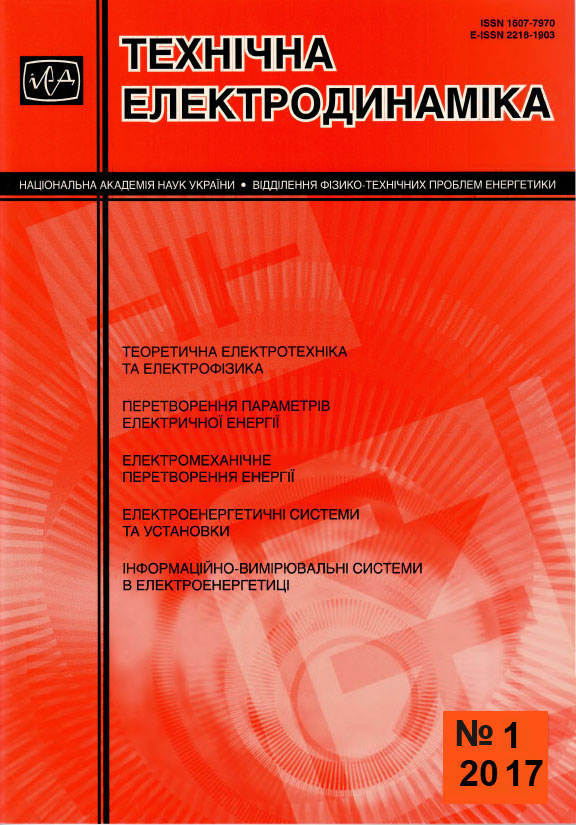Abstract
The electric field distribution in the vicinity of stress cone of high-voltage XLPE insulated cable termination (110 kV) is studied by computer modeling. The dependence of cable insulation conductivity on electric intensity and the different cone positions relative to the cutting ends of the cable outer semiconducting layer and copper wire shield are taken into account. The stress control cone is considered both in the form of only cone reflector and as a complete stress cone with insulation body. The peculiarities of field distribution depending on the cone shape and surface roughness are analyzed. The attained results are of interest for designing and improvement of up-to-date high- and extra- high-voltage cable terminations. References 13, figures 5, table 1.
References
Berger L.I. Dielectric strength of insulating materials. Handbook of Chemistry and Physics. CRC Press/Taylor and Francis Group: Boca Raton, FL, 2006. – Pp. 42–46.
Chen C., Liu G., Lu G., Jin W. Influence of cable terminal stress cone install incorrectly. Proceedings of IEEE 9-thInternat. Conference on the Properties and Applications of Dielectric Materials, ICPADM 2009. 19–23 July 2009. Pp. 63–65.
Comsol multiphysics modeling and simulation software. URL: http://www.comsol.com/ (accessed 12 July 2016).
Donzel L., Greuter F., Christen T. Nonlinear resistive electric field grading. Part 2: materials and applications. IEEE Electrical Insulation Magazine. 2011. Vol. 27. No 2. Pp. 18–29.
Egiziano L., Tucci V., Petrarca C., Vitelli M. Effect of thermal and mechanical stresses on the electrical properties of stress grading materials // IEEE Internat. Conference on Conduction and Breakdown in Solid Dielectries.
Sweden, June 22–25, 1998. Pp. 553–556.
Guk D.А., Kamenskij M.К., Makarov L.E., Obraztsov V.L., Shuvalov M.Yu. New high-voltage testing center of Joint-stock company "VNIIKP". Experience of testing and study of power cables, accessories and materials for their production. Kabeli i Provoda. 2014. No 5 (348). Pp. 35–42. (Rus)
Gurin A.G., Gontar Yu.G. Failure of surface layer of a dielectric in end cable terminations under the action of lightning surges. Visnyk NTU "KhPI". 2013. No 59 (1032). Pp. 53–60. (Rus)
Hampton N. HV and EHV cable system aging and testing issues. Chapter 3. – University System of Georgia, Institute of Technology NEETRAC – National Electric Energy Testing, Research and Application Center. Georgia Tech Research Corporation, February 2016. 19 p. URL: http://www.cdfi.gatech.edu/publications/3-HV-Issues-7_with-Copyright.pdf (accessed 12 July 2016).
Kotov R.V. Electric field distribution in cable cold shrink terminations. Elektro. 2006. No 5. Pp. 40–44. (Rus)
Kucheriava I.M. Modeling of electric field in cable termination with stress control tube. Tekhnichna Elektrodynamika. 2016. No 6. Pp. 3–9. (Rus) DOI: https://doi.org/10.15407/techned2016.06.003
Olsson C.О. Modelling of thermal behaviour of polymer insulation at high electric dc field. Proceedings
of the 5-th European Thermal-Sciences Conference. The Netherlands, 18–22 May, 2008. 8 p. URL: http://citeseerx.ist.psu.edu /viewdoc/download?doi=10.1.1.491.3890&rep=rep1&type=pdf (accessed 12 July 2016).
Pilling Yu., Haim K-D, Bersh R. Silicone for cable accessories. Advantages are in chemical characteristics. Novosti Elektrotekhniky. 2004. No 4 (28). URL: http://www.news.elteh. ru/arh/2004/28/11.php (accessed 12 July 2016). (Rus)
Zeveke G.V., Ionkin P.A., Netushil A.V., Strakhov S.V. Foundations of the circuit theory. Moskva: Energoatomizdat, 1989. 528 p. (Rus)

This work is licensed under a Creative Commons Attribution-NonCommercial-NoDerivatives 4.0 International License.
Copyright (c) 2022 Array





